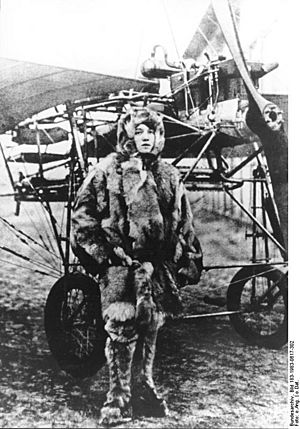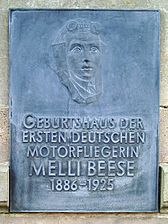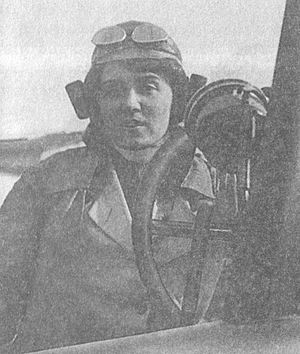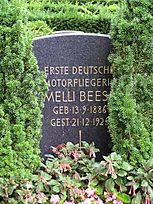Amelie Beese facts for kids
Quick facts for kids
Amelie Hedwig "Melli" Boutard-Beese
|
|
|---|---|

Melli Beese in front of the Poulain monoplane by Beese and Charles Boutard in December 1911
|
|
| Born |
Amelie Hedwig Beese
13 September 1886 |
| Died | 22 December 1925 |
| Other names | Melli Beese |
| Occupation | aviator |
Amelie Hedwig Boutard-Beese (born September 13, 1886 – died December 22, 1925), also known as Melli Beese, was a brave and early German female pilot. She made history by becoming the first woman in Germany to earn a pilot's license.
Contents
Melli Beese: A Pioneer in German Aviation
Melli Beese was born in Dresden on September 13, 1886. Her father, Friedrich Karl Richard Beese, was an architect. From a young age, Melli showed a strong interest in learning and trying new things.
Early Dreams and Studies
In 1906, Melli decided she wanted to be a sculptor. However, German art schools at the time did not accept female students. So, she traveled to Stockholm, Sweden, to study at the Royal Academy. She studied there from 1906 to 1909. During this time, she created several artworks and even won an award for a sculpture called The Soccer Players. She also learned to sail and ski.
When Melli returned to Dresden in 1909, her father built her a special studio at their new home. Around this time, flying was becoming very exciting in Germany. People were talking about Louis Bleriot's famous flight across the English Channel. Melli became very interested in airplanes and decided she wanted to become a pilot.
Her father encouraged her to study mathematics and engineering at Dresden's Polytechnic School. He hoped she might get bored, but Melli was serious. Less than a year later, she convinced him to support her dream. He agreed to pay for her to attend a flying school in Berlin.
Learning to Fly: Challenges and Triumphs
In November 1910, Melli went to Johannisthal, Berlin's first airfield. This was a busy place where pilots and airplane builders gathered. Melli found it hard to find someone to teach her to fly because she was a woman.
Finally, Robert Thelen, a chief engineer at an airplane company called Ad Astra, agreed to teach her. Melli worked in the engineering shop and took flying lessons whenever Thelen had free time. In December 1910, she took her first flight. Soon after, she had a serious accident during a flight demonstration. She was injured, and her father sadly passed away shortly after hearing about it. Her family wanted her to stop flying, but Melli was determined.
She returned to Johannisthal in January 1911. It was still difficult to find instructors, as flying tests had become stricter. However, in May, she found a new teacher, Robert Von Mossner, in Weimar. For the first time, Melli was allowed to control an airplane by herself!
Encouraged, Melli returned to Johannisthal. The director of the airfield, Georg von Tschudi, and airplane designer Edmund Rumpler decided to take her on as a student. They thought having a female pilot would create exciting publicity for an upcoming air show.
Melli faced many challenges, including other pilots trying to sabotage her aircraft. But she didn't give up! On September 13, 1911, her 25th birthday, Melli Beese flew a Rumpler-Taube airplane unaided. She earned German pilot's license No. 115, becoming the first female pilot in Germany.
Building a Flying School and New Aircraft
The year 1912 was very busy for Melli. She opened her own flying school, the Melli Beese Flying School, at Johannisthal airfield. Her mother and a businessman helped her financially. She partnered with a Frenchman named Charles Boutard and Hermann Reichelt. They bought three planes, and the school had a good safety record.
Designing Airplanes
The German government started a program to raise money for aviation technology and training. They saw that airplanes could be important for the military. Melli hoped to get funding for her work. However, because her partner Charles Boutard was French, their company couldn't get contracts related to the military.
Melli used her early training in architecture to design a new, cutting-edge airplane. She even patented a special collapsible aircraft design. She later worked with Charles Boutard on plans for a flying boat.
Life During World War I
Melli and Charles Boutard became very close and married on January 25, 1913. They lived in Berlin-Johannisthal.
After marrying Charles, Melli became a French citizen because, at that time, German law said a woman took her husband's citizenship if he was a foreigner. This meant she could not work on German airfields or with German aircraft during World War I. She and Charles were even arrested and faced difficulties because of his nationality. Charles was held in a special camp, and they moved to Wittstock for the rest of the war.
After the war ended in 1918, the Beese-Boutards tried to get compensation for their belongings that were taken during the war. These lawsuits continued for many years. Germany also faced a period of very high inflation, which meant money lost its value quickly. Despite these problems, Melli planned to make a film about her flying experiences. Some parts of this film still exist today.
Legacy of a Pioneer

Melli Beese passed away on December 22, 1925, in Berlin. She is buried in the cemetery at Berlin-Schmargendorf.
Melli Beese left a lasting mark on aviation history.
- There is a small park named after her in Wilmersdorf.
- In 1992, a street in Treptow was renamed Melli-Beese-Straße.
- The Heimatmuseum in Treptow has an exhibition dedicated to her.
- The Johannisthal airfield, where Melli started her flying career, no longer exists, but nearby street names like Pilotenstraße (Pilot Street) and Segelfliegerstraße (Glider Pilot Street) remember its history.
- In 1993, a flying club in Berlin was formed and named Aeroclub Mellie Beese.
- In 2004, a path in the Tempelhof district of Berlin was named the Melli-Beese-Promenade.
- Her life also inspired a novel by Aris Fioretos in 2020.
Melli Beese's story shows incredible courage and determination. She broke barriers and paved the way for future female aviators.
Images for kids




